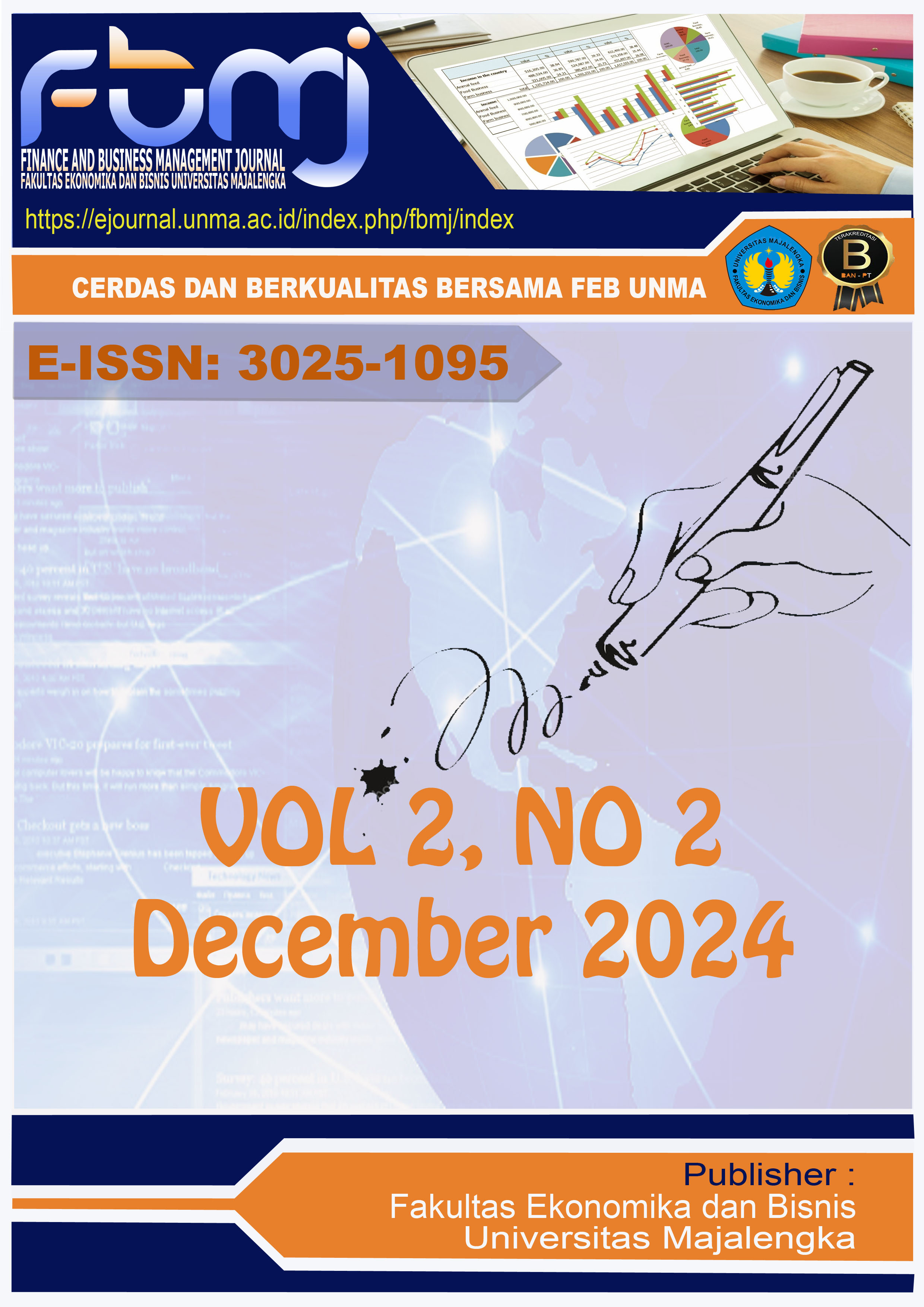Determinants of the Effective Tax Rate: A Study on Food and Beverage Companies
DOI:
https://doi.org/10.31949/fbmj.v2i2.11523Abstract
The effective tax rate is intended to measure the portion of a company's actual tax payments relative to its commercial profits. The percentage of effective tax rates for companies has significantly declined due to a reduction in profit levels. This study seeks to examine the influence of Related Party Transactions, Capital Intensity, and Inventory Intensity on the Effective Tax Rate of Food and Beverage Manufacturing Companies listed on the Indonesia Stock Exchange from 2017 to 2022. The research utilizes quantitative, secondary data sourced from the companies' annual financial reports.
The methodology employed includes descriptive and verification analysis. The population consists of Food and Beverage Manufacturing Companies listed on the Indonesia Stock Exchange during the 2017–2022 period. A purposive sampling technique was used, resulting in a sample of 10 companies, with a total of 60 data points. The study applies the Fixed Effect Model, analyzed using the Eviews 9 software. Data analysis incorporates the classical assumption test, multiple linear regression, determination coefficient analysis, and hypothesis testing through the t-test. The findings reveal that Related Party Transactions have no significant impact on the Effective Tax Rate, Capital Intensity has a significant effect, while Inventory Intensity does not influence the Effective Tax Rate.
Keywords:
Special Relationship Transactions, Capital Intensity, Inventory Intensity, Effective Tax RateDownloads
References
Ade, N., & Irwan, S. (2019). The Effect of Good Corporate Governance and Special Relationship Transactions on Effective Tax rate. Renaissance Journal, 4(02), 583-598.
Ahmad, R., & Suci, A. (2019). The Effect of Leverage, Profitability, Capital Intensity, Earnings Management on Tax Avoidance. ECONBANK: Journal of Economics and Banking, 1(2), 135-142. https://doi.org/10.35829/econbank.v1i2.48
Andi, P., & Sartika, W. (2021). Capital Intensity, Leverage, Return on Asset, and Company Size on Tax Aggressiveness. Journal of Accounting, 13(1), 134-147. https://doi.org/10.28932/jam.v13i1.3519
Chairil, A. P. (2013). Taxation Management: Tax & Business Planning Strategies (Revised Edition). Gramedia Pustaka Utama, Jakarta
Cici, D. A., & Anissa, H. P. (2020). The Effect of Profitability, Capital Intensity, Inventory Intensity, and Leverage on Tax Avoidance. 137-153. http://repository.uin-suska.ac.id/58893/
Eva, F. A. (2018). The Effect of Profitability, Capital Intensity, and Inventory Intensity on Effective Tax Rate. Faculty of Economics and Business, Majalengka University.
Gatot, S. (2020). Tax & Funding of Indonesian Civilization. Elex Media Komputindo. Jakarta
Hana, N., Zirman, & Devi, S. (2021). The Effect of Profitability, Leverage, Capital Intensity Ratio and Independent Commissioners on Tax Management. Riau Caltex Polytechnic Journal. Journal of Financial and Business Accounting, 14(1), 93-102. https://jurnal.pcr.ac.id/index.php/jakb/
Masyithah, K. Y. Z., & Desrir, M. (2020). The Effect of Corporate Social Responsibility, Capital Intensity and Audit Quality on Tax Avoidance. Journal of Master of Accounting Trisakti, 7(1), 25-40. https://doi.org/10.25105/jmat.v7i1.6315
Rizki, F. S., I Nyoman, P. Y., & Gusti Ayu, K. R. D. (2020). Analysis of Factors Affecting Effective Tax Rates on Corporate Taxpayers (Study of Real Estate & Property Companies Listed on the Indonesia Stock Exchange for the 2016-2018 Period). JIMAT (Scientific Journal of Accounting Students), 11(1), 56-65. https://ejournal.undiksha.ac.id/index.php/S1ak /article/view/24644
Rizky, W., & Dul, M. (2020). The Effect of Size, Leverage, Profitability, Inventory Intensity, Corporate Governance, and Capital Intensity Ratio on Tax Management (Empirical Study of Manufacturing Companies Listed on the Indonesia Stock Exchange for the 2016-2018 Period). Diponegoro Journal Of Accounting, 9(4), 1-12. http://ejournal-s1.undip.ac.id /index.php/accounting
Sarah, G., & Nera, M. M. (2023). The Effect of Transfer Prices and Special Relationship Transactions on Tax Avoidance with Profitability as a Moderating Variable in Infrastructure Companies Listed on the Indonesia Stock Exchange for the 2016-2021 Period. Pearl Journal of Accounting Science (JUMIA), 1(2), 184-203.
Vika, R., & Titik, M. (2019). The Effect of Size, Leverage, Profitability, and Capital Intensity Ratio on Effective Tax Rate (ETR). Journal of Finance and Accounting Research, 8 (4). https://doi.org/10.25134/jrka.v5i2.2008
Wiwi, H., & Faisal, R. (2020). The Effect of Tax Burden and Debt Covenant on Transfer Pricing in Manufacturing Companies Listed on the Indonesia Stock Exchange for the Period 2013-2017. Journal of Accounting and Financial Research, 8(3), 551-558. www.kemenkeu.go.id,

Published
How to Cite
Issue
Section
License
Copyright (c) 2024 Mochamad Febri Sayidil Umam

This work is licensed under a Creative Commons Attribution-ShareAlike 4.0 International License.
An author who publishes in the Finance and Business Management Journal agrees to the following terms:
- Author retains the copyright and grants the journal the right of first publication of the work simultaneously licensed under the Creative Commons Attribution-ShareAlike 4.0 License that allows others to share the work with an acknowledgment of the work's authorship and initial publication in this journal
- The author is able to enter into separate, additional contractual arrangements for the non-exclusive distribution of the journal's published version of the work (e.g., post it to an institutional repository or publish it in a book) with the acknowledgment of its initial publication in this journal.
- The author is permitted and encouraged to post his/her work online (e.g., in institutional repositories or on their website) prior to and during the submission process, as it can lead to productive exchanges, as well as earlier and greater citation of the published work













